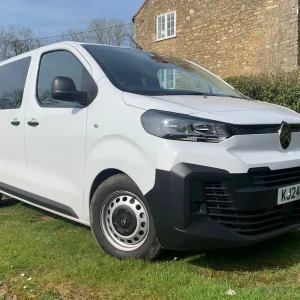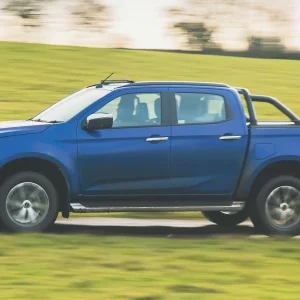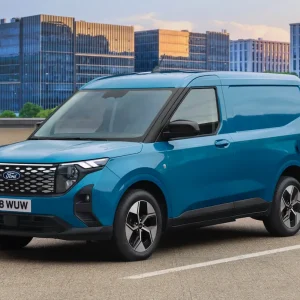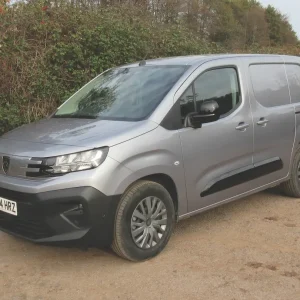The Transit Custom has been a runaway success since its launch and has just received a facelift.
Changes include a reworked front end with a three-bar grille and, more importantly, a completely redesigned cab interior with plenty of storage. New to the line-up is an Econetic variant said to offer better fuel efficiency and with CO2 emissions set at 148g/km, according to official figures.
New onboard technologies available include Intelligent Speed Assist designed to help drivers remain within the prevailing legal limit, and Blind Spot Information System with Cross Traffic Alert. The latter is there to stop you colliding with oncoming vehicles when reversing onto a main road.
Worthy of mention too is Pre-Collision Assist with Pedestrian Detection. A radar- and camera-based emergency braking system, it will now respond if the headlights illuminate pedestrians who have wandered into the Custom’s path at night, and is a potential life-saver.
A plug-in hybrid Custom will go into series production in 2019. Otherwise it is the same mixture as before, and none the worse for that.
Power comes courtesy of a 2.0-litre EcoBlue diesel at 105hp, 130hp or 170hp, and the Transit Custom is offered with two overall lengths and two roof heights. Gross weights range from 2.6t to 3.4t while cargo space extends from 6.0m3 to 8.3m3.
The specification walk is Base, Trend, Limited and top-of-the-range Sport, and the Custom van is additionally available as a six-seater Double Cab-In-Van or a nine-seater Kombi.
We decided to sample a L1H1 short-wheelbase standard roof van in Limited trim with 130hp on tap and in gleaming white.

Load bay
Access to the 6.0cm3 cargo area is by means of a sliding side door and twin rear doors that can be swung through 90°, or through 180° if you release the prominent, easy-to-use, stays.
A full-height steel bulkhead protects the occupants of the cab from unsecured, shifting loads.
A flap at the bottom allows the cargo bed to be extended so that extra-long items can be pushed into the space underneath the passenger seats. It boosts available load length to 3,037mm.
Eight load tie-down points are provided, including one above each of the wheel boxes and two at the bottom of the bulkhead, and two lights provide decent illumination if you are loading or unloading at night.
A tailored plastic cover protects the cargo bed, and ply panels offer the sides and doors partial protection against minor dents and scrapes.
There is no such protection for the wheel boxes, however, and the entire load area really needs timbering out.
Front-wheel drive means an attractively low rear loading height of just 588mm.

Interior and equipment
One of the big plus-points of the three-seater cab’s interior redesign is the ample provision of storage space, a change made in response to customer criticisms.
You will find four shelves on top of the fascia – one of which plays host to a 12V power point and a USB socket – plus three shelves and bins of various sizes in each of the doors.
Both doors boast a moulding that will hold a flask of tea, and round holsters at each end of the dashboard can take a 2.0-litre bottle of water. Above each of them you will find a cup-holder, and a third cup-holder pops out of the projecting central moulding that plays host to the gear lever.
A lidded and lockable glovebox is fitted and you can access the void under the passenger seats by pulling up the cushions and folding them forward. Flip down the centre of the back of the inboard passenger seat and it turns into a desk complete with two more cup holders, a pen tray and an elasticated band to keep your paperwork in place.
A small shelf is mounted above the windscreen while your sunglasses can be housed in a holder above the driver’s door in the place usually occupied by a grab handle.
Dominating the centre of the dash is a fashionable 8in tablet-inspired colour touchscreen featuring a DAB/AM/FM radio and Ford’s easy to comprehend and use Sync3 communications and entertainment system. It can be integrated with AppLink, Apple CarPlay and Android Auto and allows voice commands to be use to control certain functions.
Emergency Assistance is provided with all Customs and means that help will be summoned promptly if there is an accident.
Air-conditioning is installed along with heated driver and passenger seats, cruise control, driver and passenger airbags and front fog lights. Both the leather-trimmed steering wheel and the driver’s seat can be altered for height, and the angle of the seat cushion can be altered too.
Electric windows and electrically adjustable and heated exterior mirrors are fitted, with the latter featuring a separate wide-angle section. The windscreen is heated as well, and you will find a second 12V power point in the middle of the fascia.
An onboard computer generates useful pieces of information such as fuel consumption and the vehicle’s remaining range.
Although the aforementioned projecting moulding affects the legroom offered by the middle seat, it is better than one might expect, while a whole plethora of onboard systems are there to keep you safe whichever seat you sit in. The Custom comes with ABS, electronic stability control with Load Adaptive Control, Roll Stability Control, hill-start assist, emergency brake assist, electronic brakeforce distribution, Emergency Brake Warning, Side Wind Stabilisation, and traction control.
Turning to the suspension, an independent system is installed at the front with MacPherson struts and variable-rate coil springs plus a stabiliser bar. Leaf springs are fitted at the back.
Our test van’s 16in alloy wheels were shod with 215/65 R16 C Continental Vanco 2 tyres, and a spare wheel is provided.
Power steering delivers a 10.9m turning circle.

Engine and gearbox
AdBlue is required to ensure the Transit Custom’s four-cylinder 16-valve Ecoblue diesel meets Euro6. You will find the reservoir inlet under the flap that covers the diesel filler point and the 21-litre reservoir usually requires replenishing every 6,000 miles.
With common-rail direct fuel-injection operating at 2,000 bar, a variable-geometry turbocharger and a particulate filter, the engine’s top torque of 385Nm bites across a 1,500-2,000rpm rev band. Maximum power kicks in at 3,500rpm.
A six-speed manual gearbox comes as standard, with a six-speed automatic available as an option.
Driving
The Transit Custom’s mid-term facelift has thankfully not affected its road manners.
Handling is just as good as it ever was, with a combination of responsive steering
and compliant suspension allowing you to sweep through tight bends without breaking sweat.
Moving from one gear to another takes barely more effort than flicking a light switch, and the 130hp diesel offers a lot more performance than it appears to do on paper. It allows brisk acceleration from rest and pulls strongly through the rev band, and noise is never a concern.
Maybe the ride could stand to be better damped, but that is a minor issue when weighed against all the plus points.
Any other criticisms? An intermittent squeak from somewhere deep in the dashboard proved an irritation and suggests that somebody, somewhere, forgot to tighten a screw. It’s a pity given that the fit and finish of the materials used in the cab were otherwise top-notch.


Operating
The Custom is protected by a three-year/100,000-mile warranty plus a 12-year perforation corrosion warranty. Service intervals are set at two years/36,000 miles.
Like the bumpers, mirror casings and door handles, the side rubbing strips are colour-keyed on Limited models and help protect the Custom from minor damage.
Front and rear parking sensors make more serious harm less likely, with warning beeps and a schematic on the aforementioned touchscreen alerting you when you get too close to an obstacle.
If you still manage to reverse or drive into something, then at least there is the consolation that multi-piece bumpers are fitted.
That means they may not have to be replaced in their entirety if they suffer damage.
It seems a pity that the manufacturer has abandoned a long-standing approach to security that means the ignition key has to be used to unlock the bonnet.
A clearly marked lever in the cab plus a catch under the lid’s leading edge are employed instead.
It’s good to see that the van is protected by a Thatcham Category 1 alarm though which is standard with Trend trim. All the doors automatically lock at speeds above 5mph too.
Furthermore, if you unlock your van and none of the doors is opened after 45 seconds, they all lock again.
Fuel economy is exemplary. Despite high-speed runs down the M5 and trips up and down the switchback hills of Gloucestershire’s Forest of Dean, we were unable to push the Custom below the claimed combined economy figure of 46.3mpg.
Make stop/start standard and doubtless it would be even better.
|
Transit Custom Limited 280 L1H1 2.0 TDCi 130hp EcoBlue |
|
|
Price (ex VAT) |
£25,450 |
|
Price range (ex VAT) |
£20,995-£30,900 |
|
Gross payload |
885kg |
|
Load length |
2,554mm |
|
Load width (min/max) |
1,390/1,775mm |
|
Load bay height |
1,406mm |
|
Load volume |
6.0m3 |
|
Loading height |
588mm |
|
Rear door aperture |
1,404×1,347mm |
|
Side door aperture |
1,030×1,324mm |
|
Gross vehicle weight |
2,800kg |
|
Braked trailer towing weight |
2,500kg |
|
Residual value |
22.2% * |
|
Cost per mile |
48.1p |
|
Engine size/power |
1,995cc, 130hp @ 3500pm |
|
Torque |
385Nm @ 1,500-2,000rpm |
|
Gearbox |
6-spd |
|
Fuel economy |
46.3mpg |
|
Fuel tank |
80 litres |
|
CO2 |
161g/km |
|
Warranty |
3yrs/100,000mls |
|
Service intervals |
2yrs/36,000mls |
|
Insurance group |
33E |
|
Price as tested |
£25,450 |
|
* After 4yrs/80,000mls; Source: KwikCarcost |
|
The Final Verdict
|
Design |
8/10 |
Well thought-out and attractive package with user-friendly cab. |
|
Cabin |
8/10 |
Ample storage space and easy-to-use controls. |
|
Ride |
7/10 |
Competent enough but at times struggles with poor surfaces. |
|
Refinement |
7/10 |
Noise is, generally, not an issue and the van is well put together. |
|
Load area |
7/10 |
Good to see two interior lights and a load-through facility. |
|
Handling/performance |
9/10 |
Both are to a high standard. |
|
Engine/transmission |
9/10 |
A well-matched combination. |
|
Standard equipment |
7/10 |
Most of what you need is in place. |
|
Operating costs |
8/10 |
Decent warranty, long service intervals and respectable mpg. |
|
What Van? subjective rating |
8/10 |
An excellent package that is sure to be a marketplace winner. |
Rivals
Peugeot Expert
Price (ex VAT) £19,090-£28,515
Load volume 4.6-6.1m3
Gross payload 1099-1499kg
Engines 95hp, 115hp 1.6 diesel, 120hp, 150hp, 180hp 2.0 diesel
Verdict: An impressive package with most of the facilities a driver is likely to need, while a decent warranty, sensible service intervals and acceptable economy should keep operators happy. The Expert is also marketed through Citroen dealers as the Dispatch and with Toyota as the Proace.
Vauxhall Vivaro
Price (ex VAT) £21,680-£27,180
Load volume 5.2-8.6m3
Gross payload 989-1,280kg
Engines 95hp, 120hp, 125hp, 145hp 1.6 diesel
Verdict: It’s a rebadged version of Renault’s Trafic. That explains why it won’t be around for too much longer now that Vauxhall is owned by PSA Group, which also owns Citroen and Peugeot. Expect it to be replaced next year by a new model that will use the same platform as Citroen’s Dispatch and Peugeot’s Expert.
VW Transporter
Price (ex VAT) £19,870-£37,790
Load volume 5.8-9.3m3
Gross payload718-1274kg
Engines 84hp, 102hp, 150hp, 204hp diesel
Verdict: Seemingly built to last forever, offering a pleasant driving experience, and with a strong focus on safety, the VW loses out on styling. Neither the interior nor the exterior is inspiring. But balance that against RVs that are to die for and the support of a professional van-oriented dealer network.





